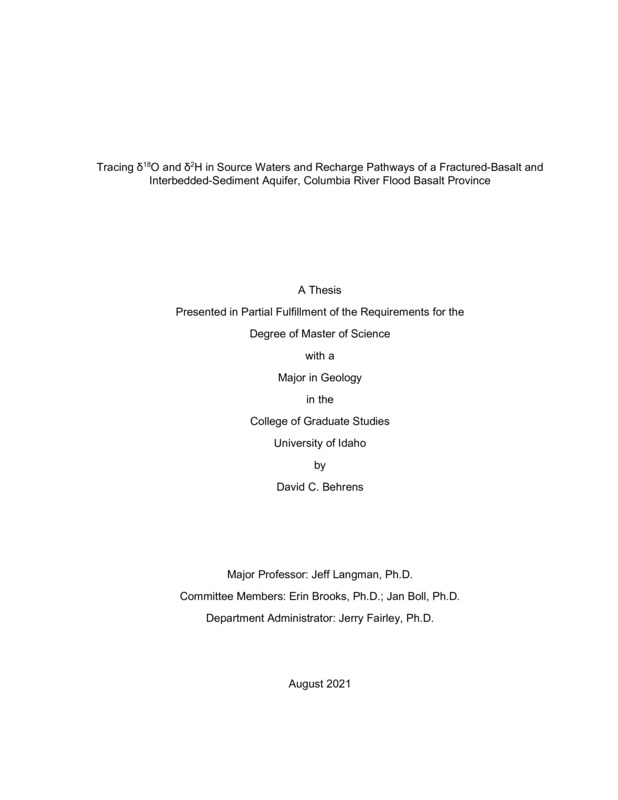Tracing δ18O and δ2H in Source Waters and Recharge Pathways of a Fractured-Basalt and Interbedded-Sediment Aquifer, Columbia River Flood Basalt Province
Behrens, David Carl. (2021-08). Tracing δ18O and δ2H in Source Waters and Recharge Pathways of a Fractured-Basalt and Interbedded-Sediment Aquifer, Columbia River Flood Basalt Province. Theses and Dissertations Collection, University of Idaho Library Digital Collections. https://www.lib.uidaho.edu/digital/etd/items/behrens_idaho_0089n_12183.html
- Title:
- Tracing δ18O and δ2H in Source Waters and Recharge Pathways of a Fractured-Basalt and Interbedded-Sediment Aquifer, Columbia River Flood Basalt Province
- Author:
- Behrens, David Carl
- Date:
- 2021-08
- Keywords:
- groundwater isotopes mixing model
- Program:
- Geology
- Subject Category:
- Geology; Hydrologic sciences
- Abstract:
-
The heterogeneity and anisotropy of fractured-rock aquifers, such as those in the Columbia River Basalt Province, present challenges for determining groundwater recharge. Entrance of recharge to the fractured-basalt and interbedded-sediment aquifer in the Palouse region of north-central Idaho is not well understood because of successive basalt flows that act as restrictive barriers. It was hypothesized that a primary recharge zone exists along the basin’s eastern margin at a mountain-front interface where eroded sediments form a more conductive zone for recharge. Potential source waters and groundwater were analyzed for δ18O and δ2H to discriminate recharge sources and pathways. Snowpack values ranged from –22 to –12 ‰ for δ18O and –160 to –90 ‰ for δ2H and produced spring-time snowmelt ranging from –16.5 to –12 ‰ for δ18O and –120 to –90 ‰ for δ2H. With the transition of snowmelt to spring-time ephemeral creeks, isotope values compressed to –16 to –14 ‰ for δ18O and –110 to –105 ‰ for δ2H. A greater range of values was present for a perennial creek (–18 to –13.5 ‰ for δ18O and –125 to –98 ‰ for δ2H) and groundwater (–17.5 to –13 ‰ for δ18O and –132 to –105 ‰ for δ2H), which reflect a mixing of seasonal signals and the varying influence of sublimation/evaporation. Inverse modeling and evaluation of matrix characteristics indicate conductive pathways associated with sandy paleochannels and deeper pathways along the mountain-front interface. Depleted isotope signals in groundwater indicate quicker infiltration and recharge pathways that were separate from, or had limited mixing with, more evaporated water that infiltrated after greater travel at the surface. These results will help further hydro-seismological investigations develop and confirm a model for potential annual volume of recharge to the groundwater system.
- Description:
- masters, M.S., Geology -- University of Idaho - College of Graduate Studies, 2021-08
- Major Professor:
- Langman, Jeff B
- Committee:
- Brooks, Erin S; Boll, Jan
- Defense Date:
- 2021-08
- Identifier:
- Behrens_idaho_0089N_12183
- Type:
- Text
- Format Original:
- Format:
- application/pdf
- Rights:
- In Copyright - Educational Use Permitted. For more information, please contact University of Idaho Library Special Collections and Archives Department at libspec@uidaho.edu.
- Standardized Rights:
- http://rightsstatements.org/vocab/InC-EDU/1.0/

